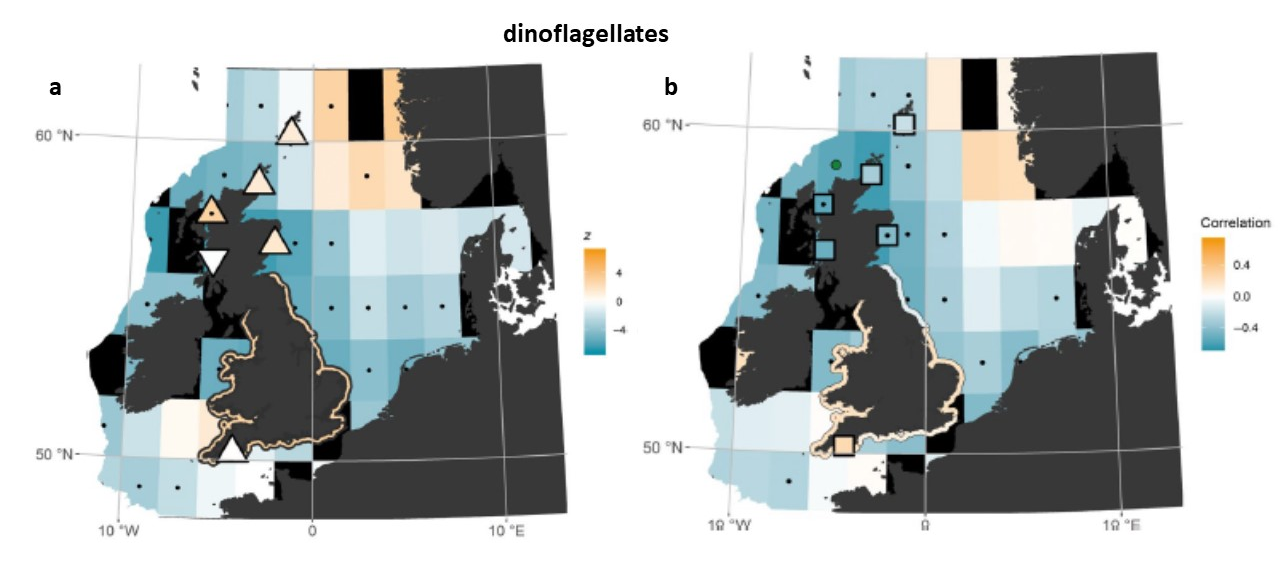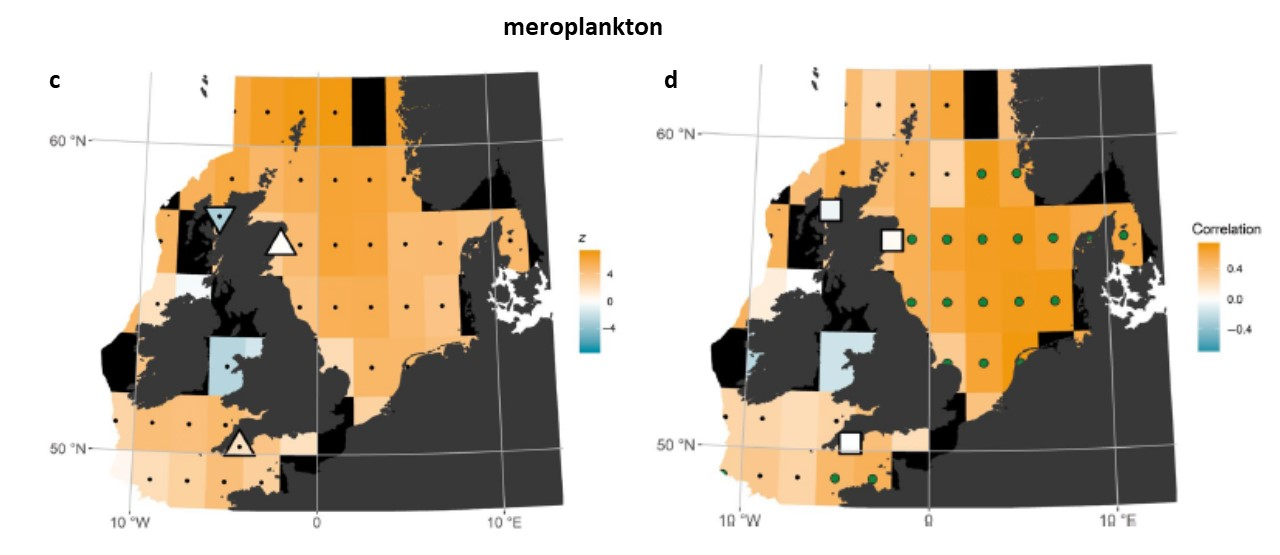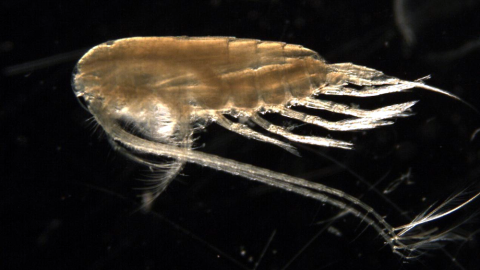Why is it important?
Plankton are microscopic, drifting plants and animals that live in the ocean. They are at the base of the marine food web and play an important role in determining the overall productivity of marine ecosystems. Through photosynthesis, marine phytoplankton convert CO2 to oxygen and sugars, therefore also contributing to oxygen in the atmosphere and ocean (see also Climate change - Dissolved oxygen). Zooplankton, which feed on phytoplankton or other zooplankton, is the food source for larval and adult fish thus transferring energy to higher trophic levels. Through their role in the food web (see Case study: Marine food webs), changes in plankton production, diversity and species distribution will have an effect on fisheries and a wide range of other marine life, including top predators such as seabirds and marine mammals.
Under certain environmental conditions, phytoplankton can increase in abundance. This is called an algal bloom. A number of phytoplankton species can have a negative impact on the marine ecosystem and the goods and services it produces. Some species can produce toxins (see also Algal toxins assessment) that can render shellfish unfit for human consumption and pose a risk to human health, other species can cause mortalities of farmed fish through production of toxins or clogging/irritation of fish gills, some form disruptive foams, scums or water discolourations. High biomass blooms can result in deoxygenation events during bloom die off which can result in mortalities of the benthos. These are called Harmful Algal Blooms or HABs. Jellyfish which are part of the zooplankton can also have a significant negative impact on the Scottish aquaculture industry, impacting gill health and causing mortalities of farmed fish. There have also been instances where jellyfish have blocked the water intake at power plants causing disruption.
What is already happening?
Data from the Continuous Plankton Recorder (CPR) have recorded changes in the plankton communities in the North Atlantic Ocean over the last six decades which have been linked to basin scale temperature trends and natural climate variability (such as the Atlantic Multidecadal Oscillation and North Atlantic Oscillation; Edwards et al., 2020). These include changes in distribution, abundance and overall biomass, as well as occurrence of sub-tropical species in temperate waters and change of season length leading to phenological changes (i.e. the timing of key events in species life cycles) that result in disruption in various predator/prey relations. It is estimated that approximately half of these changes can be attributed to climate change (Edwards et al., 2020).
CPR, Scottish Coastal Observatory and Lorn Pelagic Observatory data (along with other time series) have shown that there have been significant changes in plankton life forms (see Plankton assessment) in the North West European Shelf (Bedford et al., 2020) .
CPR data have shown changes in the distribution and abundance of phytoplankton species over the last six decades. A change in the distribution of selected HAB dinoflagellate genera in the North Sea (Edwards et al., 2006) has been observed as well as increases in the abundance of the toxin producing Pseudo-nitzschia in the North-East Atlantic since the 1990s (Hinder et al., 2012) and a shift in the phenology of some diatom species (Chivers et al., 2020). Establishing links between climate change and HABs is complex due to the multiple processes that influence bloom development (Bresnan et al., 2020).
Using the life form approach, Bedford et al. (2020) showed an increasing trend in diatom abundance and decreasing trend in dinoflagellate abundance (Figure 1a) in some areas of the North West European Shelf using CPR data. The decline in dinoflagellates in offshore areas is driven mostly by species belonging to the genus Tripos. Coastal sites show different trends with the decrease in dinoflagellate abundance not observed (Figure 1a). This could reflect a difference in the community composition between coastal and offshore areas or differences in sampling methodologies between the CPR and fixed point sites.
Bedford et al. (2020) demonstrated that trends in plankton life forms vary with area and life form, but there is not always a significant relationship with sea surface temperature (SST) (Figure 1b, 1d). Small copepods have declined significantly in offshore regions east and north of Scotland whereas meroplankton (mostly benthic larvae) have increased significantly at the same regions (Figure 1b). Meroplankton was one of the life forms that correlated significantly with SST in many marine regions (Figure 1d). The abundance increase of some meroplanktonic taxa, echinoderms and decapods, could be the direct result of wider changes in the pelagic food web (holo-/mero-plankton balance) resulting from the increase in SST and its effect on reproduction and recruitment of benthic taxa (Kirby et al., 2008). An observed decline in Calanus finmarchicus (CPR data) has been linked to poorer breeding success in black-legged kittiwakes, common guillemots and Atlantic puffins in eastern Scotland since 2000, likely to result in a northwards shift in the populations of these seabirds (Frederiksen et al., 2013). These birds feed their chicks on small fish (such as sandeels and sprat) that feed directly on Calanus finmarchicus. However, Eerkes-Medrano et al. (2017) have shown that Calanus abundance (SCObs data) was not a reliable indicator of kittiwake breeding success (Fowlsheugh colony).


Figure 1: Mann-Kendal trend scores for dinoflagellates (a), meroplankton (c) and correlations of the life forms with Sea Surface Temperature (SST) (b, d) in UK waters, using lifeform data from CPR surveys (gridded squares) and UK coastal monitoring sites (triangles). Increasing trend/positive correlation in orange and decreasing trend/negative correlation in blue. Black dots were used when a trend was significant and green dots for significant correlations with SST (from Bedford et al., 2020).
What is likely to happen in future?
Climate change will likely have an impact on the geographical distribution of plankton species, as well as the ecosystem services they provide (see Natural capital, ecosystem services and the Blue Economy assessment). Regional warming will continue to have a major effect on the plankton community affecting ecosystem services such as oxygen production, carbon sequestration, and biogeochemical cycling (Edwards et al., 2020). These changes will further affect higher levels of the food web, and therefore potentially lead to impacts on commercial fish stocks and other top predators.
A myriad processes influence the development of HABs, and current understanding and predictive capabilities are insufficient to confidently forecast the possible future impacts of HABs (Bresnan et al., 2020).
The observed changes to Scotland’s ocean climate (see Climate change - Changes in the ocean climate) are also having an impact on the marine ecosystem. In Scotland’s seas, records of changes in the abundance and distributions of important species have been collected throughout the past century, especially for those species which are economically important (commercially exploited fishes), that play key roles in ecosystems (plankton) or those that act as sentinels of ecosystem health and are valued by humans, such as seabirds and marine mammals. The following sections provide further details of why these are important, what is already happening, and what is likely to happen in future due to human-induced climate change.
The marine ecosystem and the links between its component species are complex. Species respond differently to pressure from direct human activities (such as fishing, aquaculture or shipping), as well as to changes due to climate change. The ocean’s role in Earth climate is also intricate, as natural variability on decadal and multi-decadal time scales is held in its memory. These factors result in differences in the current understanding of how human-induced climate change has had an impact and will have future impacts on the marine ecosystem and its components. This is reflected (together with the range of contributing authors) in the level of detail these sections cover.


